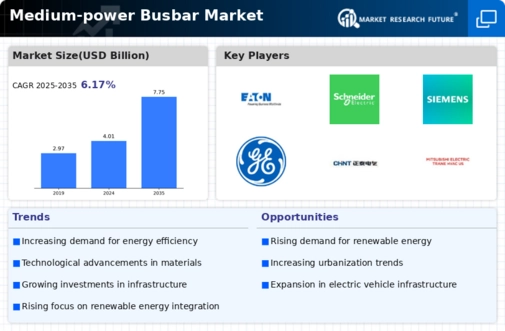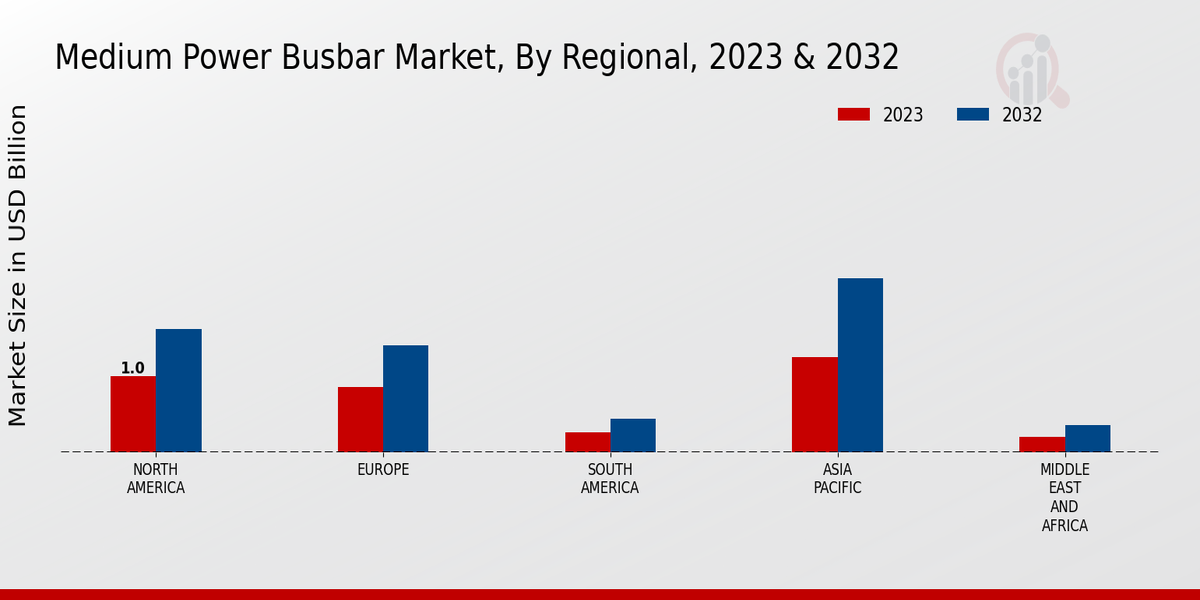Growing Demand for Energy Efficiency
The Global Medium-power Busbar Market Industry is experiencing a notable surge in demand driven by the increasing emphasis on energy efficiency across various sectors. Industries are seeking solutions that minimize energy losses and enhance operational efficiency. For instance, the adoption of medium-power busbars in manufacturing and commercial buildings has been linked to reduced energy consumption, aligning with global sustainability goals. This trend is expected to contribute to the market's growth, with projections indicating a market value of 4.01 USD Billion in 2024, reflecting a growing awareness of energy-efficient technologies.
Market Trends and Growth Projections
The Global Medium-power Busbar Market Industry is characterized by several key trends and growth projections. The market is expected to reach a value of 4.01 USD Billion in 2024, with a robust growth trajectory anticipated through 2035, where it could potentially reach 7.75 USD Billion. The projected CAGR of 6.17% from 2025 to 2035 indicates a sustained interest in medium-power busbar solutions, driven by factors such as energy efficiency, infrastructure development, and technological advancements. These trends suggest a dynamic market landscape, with opportunities for innovation and investment.
Infrastructure Development Initiatives
Infrastructure development initiatives worldwide are significantly influencing the Global Medium-power Busbar Market Industry. Governments are investing in modernizing electrical grids and expanding urban infrastructure, which necessitates the integration of medium-power busbars for efficient power distribution. For example, countries in Asia and Africa are ramping up their infrastructure projects, leading to increased demand for reliable power solutions. This trend is likely to propel the market towards a projected value of 7.75 USD Billion by 2035, as enhanced infrastructure requires robust electrical systems to support growing populations and economic activities.
Rising Industrialization and Urbanization
The ongoing trends of industrialization and urbanization are pivotal drivers of the Global Medium-power Busbar Market Industry. As urban areas expand and industries proliferate, the demand for efficient power distribution systems intensifies. This is particularly evident in developing regions where rapid urban growth necessitates reliable electrical infrastructure. The integration of medium-power busbars in new industrial setups and urban developments is becoming commonplace, thereby fostering market growth. The anticipated increase in market value to 7.75 USD Billion by 2035 underscores the importance of addressing the power needs of burgeoning urban populations.
Technological Advancements in Busbar Systems
Technological advancements are reshaping the Global Medium-power Busbar Market Industry, with innovations enhancing the performance and reliability of busbar systems. The introduction of smart busbars equipped with monitoring capabilities allows for real-time data analysis, improving maintenance and operational efficiency. These advancements not only reduce downtime but also extend the lifespan of electrical systems. As industries increasingly adopt these technologies, the market is poised for growth, with a projected CAGR of 6.17% from 2025 to 2035, indicating a robust shift towards modernized electrical infrastructure.
Regulatory Support for Renewable Energy Integration
Regulatory frameworks promoting renewable energy integration are significantly impacting the Global Medium-power Busbar Market Industry. Governments are implementing policies that encourage the use of renewable energy sources, necessitating the deployment of medium-power busbars for effective energy distribution. For instance, initiatives aimed at increasing the share of renewables in the energy mix require robust electrical infrastructure to handle variable power inputs. This regulatory support is expected to drive market growth, as industries adapt to comply with new standards and enhance their energy systems to accommodate renewable sources.

























Leave a Comment